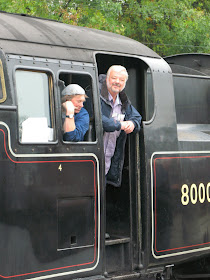
The wonderful Harrier made its last flight yesterday before the entire fleet was grounded for good. The picture attached shows a Cottesmore Harrier on the ground, the one below is of one in the air performing the very last 'bow' ever.
The Harrier; the only aeroplane that could dance. Now gone for good!
So we have new Nimrods built, ready for service, that will be cut up for scrap.
We have aircraft carriers sailing the seas with no on-board aircraft.
We have Harriers with decades of life left in them that could be on those carriers, also to be cut up for scrap.
I can suggest something else for scrapping - politicians! There are squadrons of 'em. They cost a fortune and they are mostly unproductive. Indeed it is the fiscal incompetence of one in particular (Gordon Brown) that brought about the above sad scenario!
Madness!
 The very last 'bow', RAF Cottesmore, 15th December 2010
The very last 'bow', RAF Cottesmore, 15th December 2010Link to a video of the final flights: http://www.youtube.com/watch?v=6Br0Pcjyoec
Here is an account of the day by a friend of mine who was lucky enough to attend:
I was very privileged and fortunate indeed to receive an invitation to the event at RAF Cottesmore on Wednesday.
As we arrived in the visitors' car park, it seemed that every aircraft on the Station was ranged on the flight line. Nearly, but not quite, as it turned out.
A shuttle bus took us to the event venue in the 1(F) Sqn hangar, where everyone made a bee line for the tea and coffee in order to warm up – the messing staff were going to be busy there as the day went on.
Brew in hand, the effort that had gone into preparing the hangar quickly became evident. The squadrons had moved much of their memorabilia across for the occasion, from photos of events and courses from the earliest to the latest; to fractured outriggers; to bits of downed Argentinian MB339; to a 233OCU stuffed wildcat with a biscuit on its head (?!); to a sectioned Pegasus; to competition and course trophies; to patches, keyrings, mugs, clothing and crystal tankards etc to buy; to a table full of the most astoundingly detailed plastic models from the IPMS Harrier Special Interest Group; to a large screen showing all sorts of great footage from the beginnings of the fleet up to recent Operations. There were also some stands from sponsoring organisations; one of my colleagues was showing footage from his own extensive work over much more than a decade on the VAAC Harrier, which was to have resulted in a smooth family line from Harrier to the UK's STOVL F-35B...
There were also four aircraft to get up close and personal to: 2 x GR9s, a Sea Harrier F/A2 and – delightfully – a GR Mk.1 (without the 'LASER nose').
After lunch, a live feed from the formation briefing was relayed to the big screen and in due course (punctuated by lots of people in the hangar hunched over their iPhones and Blackberrys checking TAF up-dates!) everybody trouped outside to see the weather jet/whipper-in launch into the murk, followed shortly by a stream of two ship departures.
Sadly, as we know, most of the other Station flypasts were not possible due to the met, but eventually the crowd set out from the warmth once more for the main event. This was heralded by the return of the weather ship, soon followed by 4 separate 4-ships running in to break for a stream to the hover, spaced along the runway. As each element taxied in, the next ran in overhead until there were only the final four left.
When these aircraft came into the hover, the Harrier Force Commander's jet (in the shiny 70s retro scheme) was at crowd centre. A final Harrier bow was made to the crowd, and sobs were definitely heard over the noise.
Then lights out, gear up, a 180 degree turn to face away from the crowd and Farley climb to cloudbase. A short circuit to return to a pad some distance away from the crowd line, and probably the last ever UK Harrier landing took place – vertically, of course. How could it be otherwise?
Whilst this had been going on, the three special tail jets – flown by the CO/OC of 1(F) Sqn, IV(AC) Sqn and 800NAS – had taxied between the crowd and the other aircraft, and took up three spaces of a four place crescent.
As all of the other 16 aircraft remained engines running, Gp Capt Waterfall in the retro jet taxied in (waving) from crowd left to take up the final space in the crescent.
A short pause, and then every aircraft shut down simultaneously; a dramatic and emotional effect.
All aircrew and groundcrew then gathered at the centre of the crescent (some pilots eschewing an aircraft ladder, and stepping out of the cockpit onto the intake then wing, jumping off at the wingtip) to shake hands. All walked forward to rejoin families, colleagues and friends in the crowd to a salute by the RAF Waddington Pipe Band as a final airborne surprise of three Red Arrows Hawks trailing white smoke flew overhead from behind. Dunsfold & Kingston saluting Dunsfold & Kingston.
Then back to the 1(F) hangar for a valedictory speech and thanks from Gp Capt Waterfall, the Harrier Force Commander
Following which, the bar opened.















































